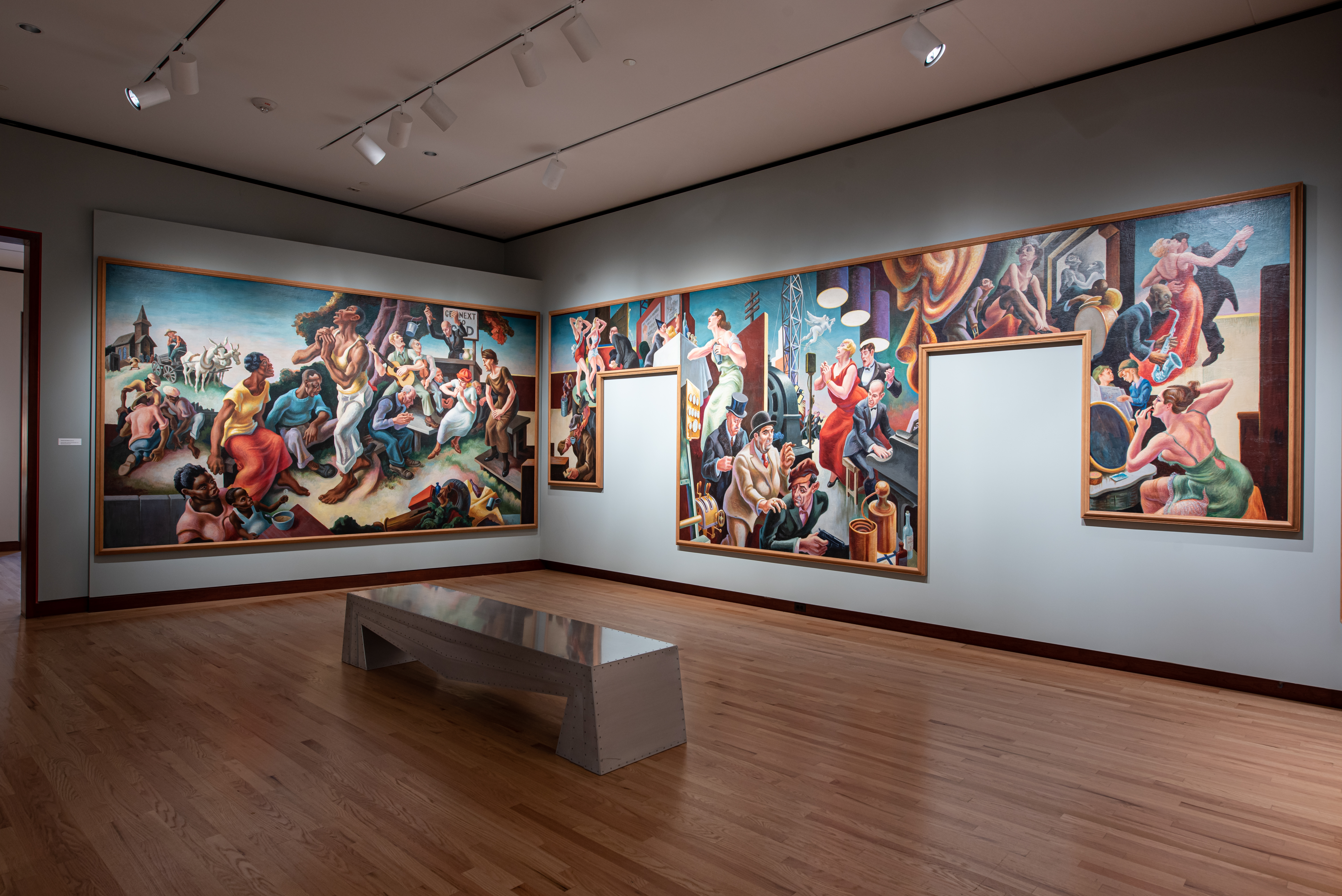Thomas Hart Benton Murals: "The Arts of Life in America"
Thomas Hart Benton (1889–1975) painted The Arts of Life in America (1932) during the depths of the Great Depression. The series provided the artist with the second most complex project of his emerging career. His slightly earlier New School Murals portrayed America at work while the Arts of Life described America at play. He was intensely ambitious and wanted to create murals that would inspire Americans to overcome the almost insurmountable difficulties they were facing.
As a young man, Benton was torn between following in the footsteps of his father, a congressman, and his great uncle, Senator Thomas Hart Benton. His mother, however, encouraged him to become an artist, and he studied at the Art Institute School in Chicago and at the Académie Julian in Paris. In Europe, he was drawn to Michelangelo’s powerful Sistine Chapel frescoes; to Peter Paul Rubens’s enormous religious depictions and elaborate political allegories at the Museé du Louvre; and to the elongated, tense, elegant figures of El Greco. The influence of all three artists is evident in the figures that populate The Arts of Life in America.
While abroad, Benton studied the Fauves, the Cubists, and the Orphists, who were creating a new visual language along with the groundbreaking advances in music and literature that were taking place prior to World War I. As never before, the powerful abstract qualities of African art proved inspirational to the artists of this generation. The works of Henri Matisse and Pablo Picasso were also well known to the young Benton.
Americans Stanton MacDonald Wright and Morgan Russell, whom Benton knew well, simultaneously developed concepts similar to those of the Orphists, calling themselves the Synchronists. Later in his career, Benton claimed that he rejected almost all the modernist theories that he had encountered early in his career, but a persuasive case can be made for their continued influence, especially that of the Orphists and Synchronists.
In 1912 Benton moved to New York, where he sought to develop a unique style that could represent a synthesis of the best of the Old Masters and the most provocative aspects of modernism. Juliana Force, director of the Whitney Studio Museum, founded by arts patron Gertrude Vanderbilt Whitney, commissioned Benton to decorate the library of the West Eighth Street building that Whitney had purchased for the purpose of promoting contemporary American art. At the time, Whitney and Force preferred the work of the Ashcan School and the Social Realists, which provided an antidote to the decorative Impressionist paintings that dominated the American art world in the 1910s and 1920s.
Benton set out to create an inspirational series of canvases that would provide the viewer with an understanding of the nature of American creativity. In his series of four murals and a lunette, he concentrated on depicting the indigenous art forms of major divisions of the country: the South, the Cities, and the West. Benton also painted a historical section devoted to Native Americans. In the final section, the lunette, he developed as a political satire.
Influenced by the works of the nineteenth-century social scientists Hippolyte Taine and Frederick Jackson Turner, Benton believed that a society represents the collective endeavors of every citizen. Accordingly, he chose to portray the daily pursuits of Americans of all ranks and conditions. It did not matter if the individual chose to dance at a speakeasy or toss horseshoes. The fact that a person was engaged in a creative pursuit of some kind represented our nation’s vitality and stimulated the collective imagination.
With his taut, elongated figures, twisting and turning, and his liberal use of brilliant reds, greens, blues, and yellows, Benton enlivened every inch of the large murals. Not only a painter, Benton was also an accomplished musician and collected scores and recordings of music from folk ballads to classical symphonies. In The Arts of Life, numerous musical instruments are depicted and men and women—young and old, white and black, rich and poor—are singing in exaltation. Benton symbolically included the wafting of music by employing the abstract multicolored Cubist rainbows of the Orphists.
When the murals were completed, many critics praised them for their vibrant colors and originality. Others condemned them as being decadent and outrageous. The artist, who was both outspoken and pugnacious, reacted by condemning anyone who did not agree with him. As a result of the fierce debate, Benton emerged as one of the most famous and influential artists of the 1930s and 1940s and the first to have his image on the cover of Time.
In 1952 the Whitney Museum decided to sell the murals for five hundred dollars, a fraction of their original cost of four thousand dollars. Avant-garde art movements, as exemplified by the work of Benton’s pupil Jackson Pollock, had supplanted Benton’s brand of radical regionalism. The New Britain Museum of American Art acquired the paintings in 1953 through the generosity of patron Alix W. Stanley and the wisdom of Director Sanford B.D. Low. They have been on display at the Museum ever since. In 1959 Benton wrote,
"The New Britain Museum is my favorite museum. . . . The reasons for this are plain—over the years it has been the most friendly for me and my efforts. When other museums were getting rid of these, the New Britain Museum was supporting them—buying them and hanging them on its walls."
Currently on view
